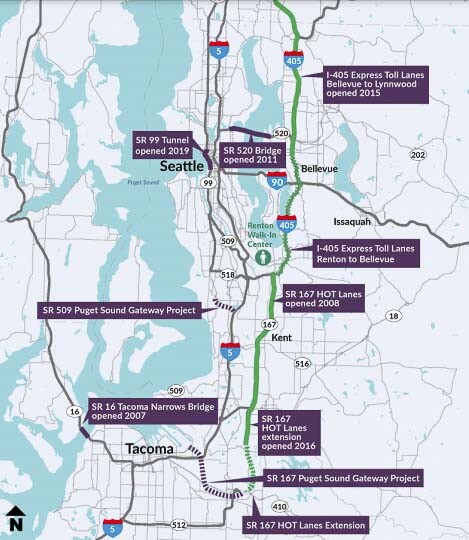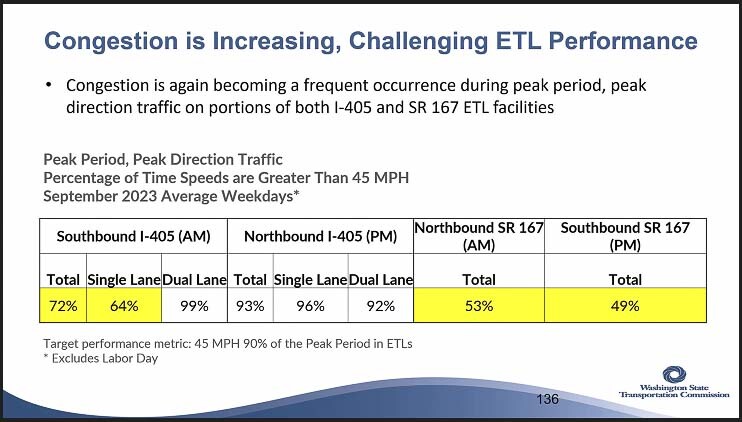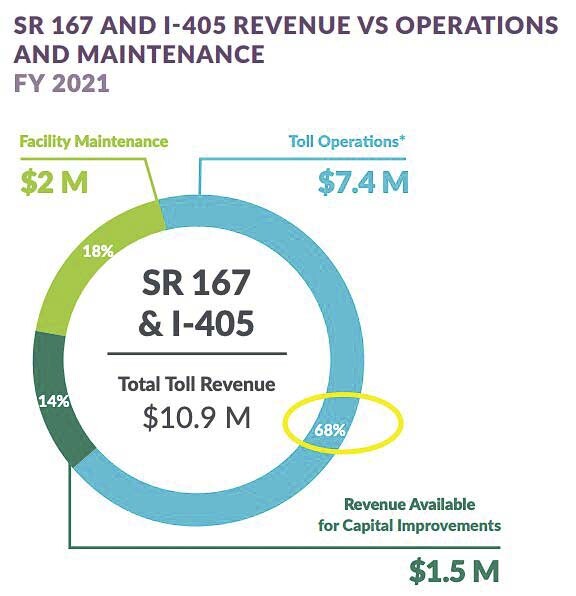State needs $1.1 billion annually for road maintenance in spite of record revenues
John Ley
for Clark County Today
“Washington’s transportation system is on a glidepath to failure” the Washington State Transportation Commission (WSTC) members were told at the beginning of their monthly meeting in Olympia. The cry for more tax dollars came from the Washington State Department of Transportation (WSDOT) staff members. They regularly mentioned that fuel taxes and the 1 percent property tax increase weren’t providing enough money for transportation, especially for local cities and counties..
The WSTC is considering increasing toll prices on the I-405/SR-167 tolling facilities to an $18 maximum rate. Due to pandemic lockdowns, state tolling revenues were down significantly and needed to be bailed out by the legislature with General Fund tax dollars. They are also considering a Road Usage Charge (RUC) to raise money.
The Washington Policy Center noted: “The increase will cost a I-405 commuter, using the lanes at peak toll periods, around $720 per month or $8,640 per year. If you travel the entire 167 and 405 corridor you could see a toll of up to $54.”

The potential 80 percent increase in maximum toll rates are of interest to Southwest Washington citizens because Oregon officials plan to implement variable rate tolling on all Portland area freeways. This would be in addition to tolls on the Interstate Bridge Replacement (IBR). It is estimated that over 75,000 Clark County residents commute to work in Oregon. Combined tolls could cost between $28 and $31 a day for round trip travel between Vancouver and Wilsonville.
Additionally, the Oregon and Washington Transportation Commissions will jointly be setting the IBR toll rates. The WSTC confirmed Clark County’s Roy Jennings and Yakima’s Jim Restucci as representatives on the bi-state toll-setting committee.
“We need to raise more money,” WSTC member Shiv Batra said in reference to future toll rates on I-405 and SR-176. Tolling began roughly 15 years ago on SR-167 and eight years ago on I-405. Staff said this is the first increase being considered. Tolls were originally proposed on I-405 to build a general purpose lane, which was later switched to a second tolled lane.
Currently there is a $275 million funding gap, according to staff. Additionally, the WSTC is considering a new Bus Rapid Transit (BRT) line as part of a $6 billion transportation improvement package for the SR-167 transportation corridor.
Recent midweek data shows southbound SR-167 hitting its $9 ceiling in 74 percent of peak afternoon hours. I-405 reached its $10 maximum 40 percent of southbound morning peak hours. Reema Griffith, WSTC’s executive director, called the tolling system “a significant failure.”
People were supposed to get the value of saving time, when they pay a toll. “If you’re paying $9 right now on 167 and you’re still in traffic, that value you should be gaining with that $9 you’re spending, especially if you’re low income — you’re not gaining that value,” Commissioner Carl See said.
State and federal law requires Express Toll Lanes (ETL) to meet speeds of at least 45 miles per hour, 90 percent of the time. Neither I-405 or SR-167 facilities meet this requirement. Southbound (morning) I-405 meets the requirement only 72 percent of the time. The SR-167 system only meets the requirement about half the time. Traffic congestion has returned to statewide highways following the end of pandemic lockdowns.

The WSTC also heard briefings from WSDOT officials indicating the state needs an additional $1.1 billion a year to pay for road and bridge upkeep. The state has 10,880 lane miles of highways that need preservation work to keep them in a state of good repair. “I implore you to stop kicking the can down the road,” said WSTC’s Kelly Fukai. She begged her fellow commissioners to prioritize where money is spent.
Amy Scarton, deputy secretary WSDOT, told the commission the 2022 Move Ahead Washington (MAW) transportation package appropriated less dollars for preservation and maintenance. “When it came time to put the money where the priorities were, we were less than enthused” at what the legislature had done, she said.
Currently, the Washington State Legislature has allocated $975 million for maintenance and repairs. The legislature chose to fund new capital projects over caring for existing roads and bridges. The $17 billion MAW transportation package was the largest in state history.
This does not include an initial $8.6 billion Washington state was expecting to receive from the $1.2 trillion Infrastructure Investment and Jobs Act (IIJA) signed by President Joe Biden. This money is added to the $6.6 billion (biennium) Washington will spend on transportation Clark County Today reported at the time. The funds were supposed to be “a game changer.”
Under the IIJA package, over the next five years Washington will receive around $4.7 billion for highways and $605 million for bridges and another $1.8 billion in public transportation spending, according to Washington Sen. Patty Murray.
According to the Tax Foundation, Washington state has the fifth highest gas tax in the nation, at 49.4 cents per gallon. But the Climate Commitment Act passed by the legislature has raised gas prices by 50-60 cents per gallon. The carbon tax has raised over $1 billion in the first 9 months. “There’s a lot of money there,” said a WSDOT staffer in reference to the carbon tax.
Unlike the gas tax which is protected by the state Constitution and gets put into a specific transportation fund, the carbon tax goes into the General Fund. Those funds have also been allocated for multiple, non transportation purposes.
According to WSDOT staff, none of the tolling increase proposals ($15 or $18 maximum) will solve the revenue problem. The proposal would also raise the minimum toll to $1. It would also add tolling on weekends, which doesn’t happen today.
Tolling has proven to be a very inefficient means of collecting taxpayer money for transportation. The cost of collecting tolls on I-405/SR-167 was 43 percent prior to the pandemic. It jumped to 68 percent a year later. The Tacoma Narrows Bridge (TNB) tolls have not covered both maintenance and costs of collection. The legislature allocated $85 million in 2018 to lower toll rates. In 2022 they allocated $130 million through 2032 to lower TNB tolls.

Area tolling news
In Oregon, the Clackamas County Commission voted last week to support IP-4. The initiative would guarantee a “Vote Before Tolls” can be placed on any Oregon highway. They need 200,000 voter signatures to place IP-4 on the November 2024 ballot.
“The legislature and ODOT are not listening to people, they need to fix it. So, maybe if citizens are going to vote on it they’ll get busy and start fixing the problem and look for alternate ways to fund our roads,” said Clackamas County Chair Tootie Smith.
Last year, the Clark County Council passed a resolution against tolling on I-5 and I-205. “The proposed tolling will have a negative impact on those who cannot vary their work hours and those who are wage employees and least able to pay for the use of their roads which tax dollars have already paid for,” said Gary Medvigy, Councilor for District 4.
“The Clark County residents who cross the bridge for work pay taxes to the state of Oregon,” said Council Chair Karen Dill Bowerman. “When we think about the additional funds from tolls that would be collected in multiple places in order to accommodate their commute — it is a good reason for this council to take a negative position on that tolling.”
Of additional interest, the WSTC approved a request from the city of Ridgefield to eliminate the state highway designation on SR-501. This highway goes around the west side of Vancouver Lake and travels north to the south end of Ridgefield.
Also read:
- Busy pavement season ahead on Vancouver streetsThe city of Vancouver is set to repave and preserve 76 lane miles across 20 neighborhoods in summer 2025, with ADA upgrades and community notices throughout.
- State representative: Expect sticker shock when Interstate Bridge project officials reveal price, tolling plansAt a town hall in Battle Ground, Rep. John Ley warned of major cost increases and tolling burdens tied to the Interstate Bridge replacement project.
- Opinion: Washington state lawmakers increase the cost of driving – againBob Pishue of Mountain States Policy Center argues that new vehicle and fuel taxes in Washington will raise driving costs while diverting funds away from roads.
- Overnight full closure of I-5 near Woodland for bridge inspection, May 6WSDOT will fully close southbound I-5 near Woodland overnight on Tuesday, May 6 for a bridge inspection using a chain drag test.
- Opinion: Do we still need TriMet?John A. Charles Jr. of the Cascade Policy Institute argues that TriMet should halt expansion plans and prepare for major service reductions in response to falling ridership and rising costs.










A bottomless pit! Us taxpayers will cover it, till nothing is left……